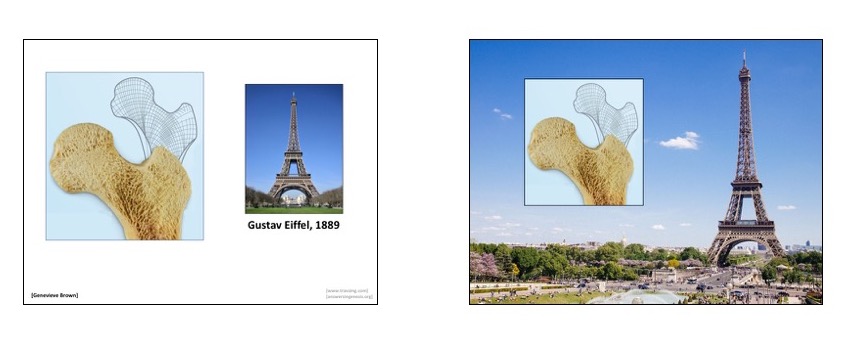Assertion-Evidence (Message-Visual)
Slide Tutorial
To create slides with stronger visuals and a clear message, begin by following the steps below. Begin creating your own slides or see examples of slides by using this starter-template.
Step 1. Put yourself in your audience's place.
The more knowledgeable we become about our topic, the harder it is to remember what it’s like to see it from a different perspective. To place us in the proper frame of mind to tailor our communication for our audience, ask yourself some basic questions: Who are the audience members? How much do they already know, and what will I need to fill in? How is the topic relevant to them? What do I want them to do after the presentation? What is the primary message I want my audience to take away?
Step 2. Write your presentation as a series of messages.
Rather than writing a phrase headline and a list of bullet points, instead think about the series of messages you want to share with your audience. What are the insights, features or results of the work, product, or idea that you want to share? Write these messages out in complete sentences, no more than 20 to 25 words.
For example, if we are giving a presentation on bone bioengineering research and need to provide some background on trabeculae, rather than say "About Trabeculae" and listing the features, we'd write out a message about one feature of trabeculae that we want to highlight. This forces us to be specific about what we want to share with the audience:
Trabeculae reduce a bone's weight while giving it maximum strength against multiple forces
Place these messages at the top of each slide, with no more than one main message per slide. Each message should be the most important takeaway you want your audience to have from the slide. To make formatting easier, use this template, which is designed for maximum readability by the audience.


When writing the messages for our presentation, we want to write in complete sentences and avoid using phrase headlines. This ensures we are thoughtful about what content to include in the presentation, and more importantly, which details to omit.
Step 3. Develop visuals that support your messages.
What is the visual that will best help your audience understand your message? Perhaps you could use an image, a diagram, data, a video or a demonstration. Do you need a visual at all? Maybe your explanation of that message, with simply a black slide behind you, will be more powerful than any visual you can create.
You can still have some words on the slides, but these words should share a message with the audience, label data or picture, or have meaning as part of a larger illustration. Keep in mind that audiences read about 180 words per minute on a slide, so the more words you have in the body of the slide, the more the audience’s attention will be taken away from you.


In the trabeculae example, the presenter, Genevieve Brown, visually supports her message with an image of trabeculae and the Eiffel Tower. When she delivers the slide, she discusses how trabeculae are so strong and light, they inspired Gustav Eiffel in his design of the Eiffel Tower.
There may be times, that you choose to leave the written message off the top of the slide and instead opt for slides with a TED-style design with clean visuals or pictures that bleed off the screen. However, the act of writing these messages and knowing them as the presenter is an important step to construct a cohesive and engaging story to share with your audience. As a general rule, the more technical the content, the more important it is to include the message on the slide to provide guidance for the audience.


In these slide examples, we've removed the message to create TED-style slides where images are the primary focus. Using these slides, the message becomes part of what the speaker delivers in the talk.
Step 4. Rehearse your talk.
The best presenters own the information they are sharing. Just like athletes practice for the big game, you need to practice your communication in order to reach a level of confidence with the material and show your passion for the work. Because you can’t read from a bulleted list, your role as a presenter will be to explain the visuals on the slide and sharing information and details that supports the main message on the slide.